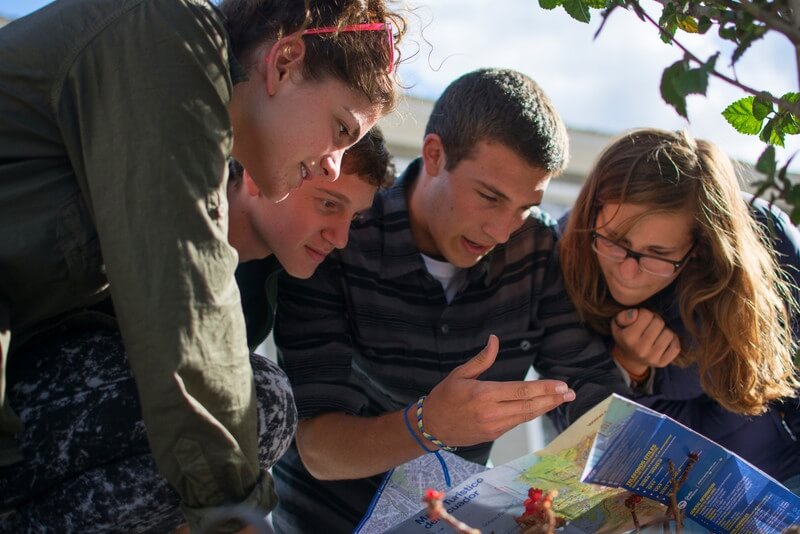Benefits of Collaboration in Education
People often say that two heads are better than one, and usually they are right. Little in life is possible without working together. Learning to work together in the education system is an important skill for students to learn now. We’ll walk you through how collaboration works in education, what the benefits are, and how to implement collaboration into your classroom.

What Does Collaboration Mean in Education?
Collaboration is working together to make something happen or to reach goals. In education, collaboration presents itself in two ways: collaboration between educators and collaboration between students. Collaboration between educators involves teachers, administrators, and staff all working together to make the school and the classroom a place of learning, safety, and growth for all students. Teacher collaboration creates a strong educational environment.
Collaboration is also for students. When students work together on projects or to reach goals, they are collaborating in education. Collaboration between students also improves the educational environment and helps foster improved learning. Students working together can take a lot of forms. They can be doing group projects, supporting each other’s ideas, having classroom discussions, leading lessons, planning activities, and more.
What Are the Benefits of Collaboration in Education?
Both teacher and student collaboration has so many benefits in education. In addition to just generally improving the educational environment, collaboration can help with so many other parts of a student’s experience in school.
Improves Brainstorming
Brainstorming is a skill students will need as they further their education and eventually go into the workforce. But it can be hard to teach students how to brainstorm well and in a way that will actually illustrate how brainstorming is important. Collaboration in education is a great way to solve that problem and help students learn to brainstorm with each other. Having students work together to come up with ideas helps them understand how brainstorming works, and the more often they collaborate, the better they’re going to get at the skill of brainstorming.
Brainstorming also helps generate creative ideas—which is why it’s so important in school and in the workplace. Creative ideas are generated in group brainstorming sessions and then put those ideas into action. Collaborative brainstorming in school is a great way to help students come up with really creative ideas that both get them excited to work and ideas that help accomplish a goal well. Collaboration is the best way to get these good ideas and to refine them into something unique and workable.
Develops High Level Thinking Skills
Collaboration also helps students develop high level thinking skills. Skills like thinking analytically and critically aren’t typically natural skills or skills that emerge when you work completely alone. But working with others and working together exposes students to new ways of thinking and new ideas—both of which help students develop higher level thinking skills that will benefit them in their educational and career goals.
Some high level thinking skills are connecting concepts, seeing the big picture, visualizing processes, problem solving, asking good questions, practical applications, and synthesizing information. All of these skills benefit students in their own work, but they’re best learned by working with others and having to collaborate to create a project. Students will learn how to ask good questions by working with others and having to ask them questions that will help move ideas forward. Collaboration helps students learn to think in new ways.
Boosts Self Confidence and Self Esteem
Collaboration does help students think in new ways, and it also helps them individually as well by boosting their self confidence and self esteem. Self esteem is how a student views themself, and school can be a rough place for some students’ self esteem. But a positive collaboration experience can actually help students view themselves in a positive way, boosting their self esteem. When a student sees how they were able to contribute something valuable to a collaborative team (even something small), they are better able to see the value they bring to the world.
Collaboration is also a good way for students to learn to be more confident in themselves. Students who are shy or unsure of themselves may have trouble speaking up in a larger class environment, but in smaller collaborative situations, they may find it easier to speak. As they gain more experience speaking in front of others, they’ll gain more confidence in sharing their ideas with larger and larger groups. Even generally confident students can use collaboration to gain more confidence in their academic abilities and ability to work with others.
Helps Leadership and Social Skills
Leadership is a very valuable skill for students to have as they continue in school and begin having new opportunities in their lives. No matter what a student is doing or what their goals are, leadership skills will be valuable. And collaboration is a great way to help students begin to develop leadership skills. Group work and projects help give students the opportunity to be a leader and to set an example for their peers. The experience of getting to be a leader in a controlled environment will help students see what works for them and what attributes they have that really makes them stand out as a leader.
Collaborating with other students also helps students practice social skills. Interacting with others is an important part of life, and school collaboration can give students the opportunity to foster those skills, to learn how to interact with others better, and to know how to treat their peers with respect. Collaborating will help students gain social skills and leadership skills that will help them no matter what they plan to do in the future.
How Can Collaboration Be Used in the Classroom?
Since collaboration can help students in so many ways, as educators it’s important to implement it into the classroom. Collaboration can be used in the classroom to foster a sense of community and teach students to work together to achieve common goals—all of which are important skills moving forward. How can collaboration be used in the classroom? These are some of the best ways:

-
Assigning team projects
Team projects will have students working together in smaller groups toward a common goal. Teams will give students the opportunity to be a leader and to learn how to work together toward a common goal. Team projects are also a regular part of the work environment students will join someday, so helping them practice working together and gaining confidence in their abilities to contribute will prepare them for more.
-
Cultivating class discussions
While it may not seem obvious, class discussions are collaborative. Students have to work together to move the discussion forward and get to learn from each other along the way. As an educator, you can foster discussions by asking poignant and prompting questions that get students thinking. You can call on students to contribute and to respond to others’ ideas to help students get started. From there, you can guide the discussion to stay on topic and respectful to everyone.
-
Encouraging student participation
Students can’t collaborate with each other if they aren’t participating. As the teacher, you can encourage students to participate in group discussions, group work, and any other activities. When they participate, they’re then benefitting from collaborative exercises. To encourage students, you can act as a mentor and show them the benefits of participating alongside the other students. Making sure everyone feels welcome in the classroom is another key way to encourage them to participate.
-
Setting class-wide goals with student input
Part of collaboration is working together toward a common goal, so having goals for the whole class is a great way to foster collaboration. But to make these goals truly collaborative, it’s best to let students contribute their own ideas to the goals. Consider setting class-wide goals at the beginning of the school year or semester with the whole class and then posting them somewhere everyone can see, so they’re reminded of what we’re all working toward.
-
Dividing students into small groups to complete assignments
It doesn’t have to be a team project to get students collaborating. Simply having students divide up into groups to complete their assignments can help them focus on collaboration and help them come up with better results in the end.
Why Is Collaboration Important in Education?
Overall, collaboration is a way for students to learn new skills, gain experience working with others, and discover how to be confident in themselves. Collaboration is something educators can implement into the classroom on so many levels and in ways that will help students start reaping the benefits of learning to collaborate.
At Global Citizen Year, we also work to foster students’ collaboration skills as part of our leadership curriculum. Our programs provide a collaborative learning environment for students to identify their strengths, values, and the impact they want to make in the world.
As an educator, you can nominate your students to participate in Global Citizen Year, so they can learn more about leadership and collaboration in ways that will benefit them wherever they are in life. Learn more about how to get started today.
Experience a day in the
life of Academy students
DAY IN THE LIFE / ACADEMY
— Ziko Petse
The thought-provoking conversations with students from all walks of life challenge and expand my worldview.…
See Ziko's StoryDAY IN THE LIFE / ACADEMY
— Camila Leão Sabará
During my gap year I'm attending the Academy and running a youth activism podcast.…
See Camila's StorySTUDENT SPOTLIGHT / ACADEMY
Meet four Academy students from around the world!…
Meet 4 StudentsDAY IN THE LIFE / ACADEMY
— Ulviya Chisty
Before starting college, I decided to join the Academy to challenge my understanding of what education looks like.…
See Ulviya's StoryDAY IN THE LIFE / ACADEMY
— Mel Richardson
Our class is so open to new ideas and discussing all sorts of interesting topics on self, community, society, and how we all intertwine! …
See Mel's StoryDAY IN THE LIFE / ACADEMY
— Rara Istifadah
I'm enrolled as a full-time college student and the Academy's been an amazing addition!…
See Rara's StoryDAY IN THE LIFE / ACADEMY
— Montserrat Ruiz
The Academy's been the best part of my gap year in Chile.…
See Montserrat's StoryDAY IN THE LIFE / ACADEMY
— Ana Isabel Amado
The Academy has been an amazing way to connect with people from all around the world and find people who share a love for making an impact. …
See Ana Isabel's Story







